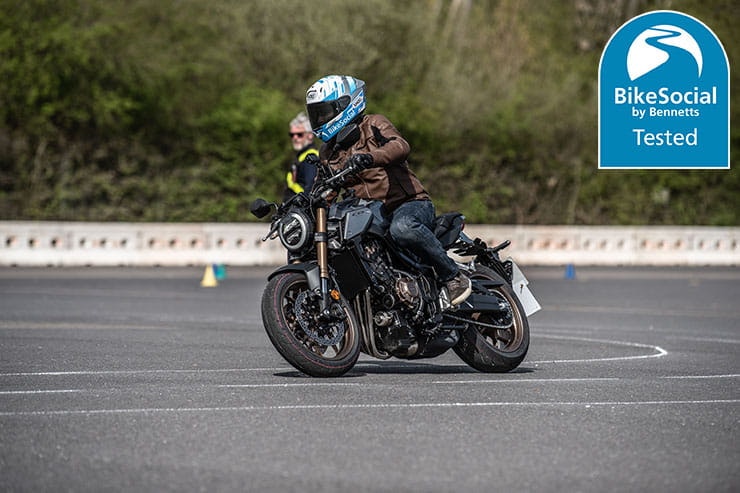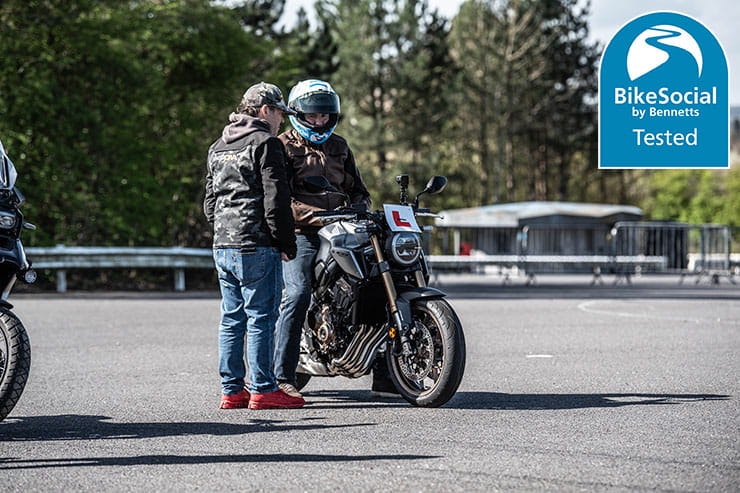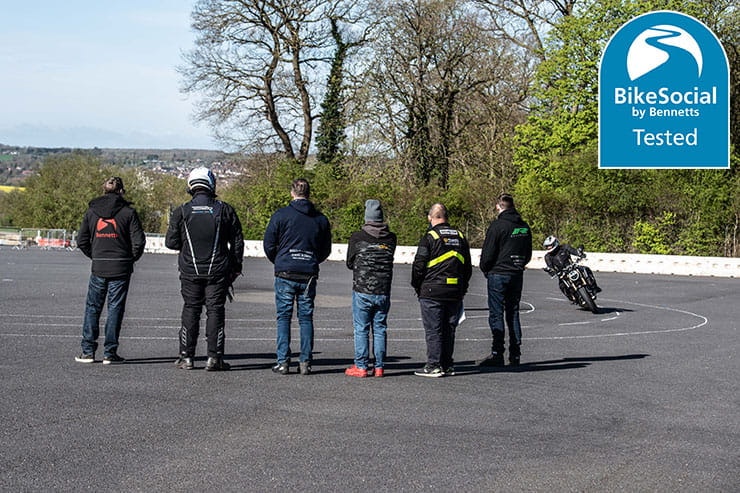Tested: motoDNA digital rider training review
By Michael Mann
BikeSocial Managing Editor
10.05.2023
Date reviewed: April 2023 | Tested by: Michael Mann | Price: £119 (£101 for BikeSocial Members) | WEBSITE: www.motodna.com
Ever fancied your very road riding coach? Now’s your chance… sort of. And for those with a competitive streak who also thinks themselves as a handy road rider then be prepared. An Australian motorcycle training school/digital academy by the name of motoDNA uses a motorcycle-mounted GoPro to collect data while you perform five challenges in the street SKILLS 101 class and, once plugged into the bespoke computer program, analyses and interprets the data then spits out a score which everyone else who’s also completed the course from around the world can see. But where on the ten-level chart between Intro and Alien will you sit?
Owned by ex-MotoGP engineer and expat, Mark McVeigh, the purpose of the short course is to increase knowledge of what a bike can do while training the brain to avoid hazards in the most effective way.
The challenges include an emergency stop, and the question raised is a simple one, when did you last practice an emergency stop? If you go out and find a quiet road to try it, ask yourself what you’ve learned because if, like me, once you’ve done it three or four times your faith in the bike’s ability particularly if it has ABS and linked brakes, it’s an extremely effective way to consider what a modern day machine can do, and now judge how quickly you can stop compared to the first time you tried the exercise.
Sometimes practicing the simplest manoeuvres might just save your life. But without getting too fixated with how vulnerable we are as road users, this digital academy analyses throttle, braking and steering inputs from the five challenges using data instead of an objective view of a pro trainer. Though it is the flesh-and-bones part (usually with a hi-viz on) who’ll interpret the scores and advise on how you can improve them.
Off we went to the Donington Park tarmac lake located on the outside of the famous circuit to dive in and of the cones with Phoenix Motorcycle Training who have licenced motoDNA for UK use.
Review: can technology teach us to be a better rider?
Using a GoPro, can we become better, more precise, and safer riders? Mr Mann looks at motoDNA’s Street Skills 101 course.
What you’ll learn
“Fast tracks your core skills, reducing your risk on the street by practicing the correct and intuitive reactions to simulate real world hazards,” says Mark McVeigh. Once riders have received training and have practised the five challenges on a course around cones placed specifically and precisely so the layout can be replicated anywhere in the world, they then have the chance to run the drills while the GoPro is recording.
The five challenges are:
Figure 8 circuit
Emergency braking
Straight line avoidance
Cornering avoidance
Slow speed balance
Using a bike provided by Phoenix Training, which on this occasion was the very friendly Honda CB650R, I had a chance to practice several laps of the figure-of-8 layout to get my eye in and understand how the bike turns. Mark offered tutelage by stopping me every lap or two and suggesting adjustments to my body position or amending gears or clutch use, or adding rear brake to help balance. And what I had dismissed as being a simple exercise, then became a useful session of fine-tuning leading to a dramatic difference between the first lap and the recorded lap. Being asked to ride at 90% of your ability certainly increased the focus and pace, though my laps were still inconsistent. Is it better to accelerate hard, brake hard and turn sharply, or to perform all actions as smoothly as possible including taking a wide line around the tighter cones? First gear, second, or both? Sitting here writing this review, I’m still not certain which approach would have scored higher, though realistically the challenge of managing low-speed, sharp manoeuvrability to test the agility of the machine was worth the entry fee alone. The more we experiment with the bike’s capability, the more confident we become at braking harder or turning sharper.
Emergency braking has the same output; the more times you practice the better we become, and with ABS-enabled bikes (and even those with cornering ABS) you’d be hard pushed to lose control of the bike. Squeeze hard with the front lever and the data showed I was pulling 1G and managed to stop from 30mph-ish in 7 metres. Though I should have used the rear too because I’d forgotten they’re not linked on the CB650R.
Straight line avoidance sees you complete one lap of the same figure-of-8 layout before diving left or right to avoid the ‘car’ depicted by small cones near the finish line. The idea being that you become familiar with sharp, emergency avoidance while braking. The problem with training to avoid hazards is that you know they’re there. Nevertheless, the reactions of the bike vs the input is the key takeaway.
Slow speed balance also uses the figure-of-8 layout over one lap, but the instruction is to travel at 6mph which focuses your skills firmly on balance. Bear in mind that coasting with the clutch out in first gear is approximately 6mph so concentration can be channelled into learning how the bike reacts with the smallest of inputs.
Cornering avoidance uses a circle with a 25-metre diameter. Follow the line in a clockwise direction for a couple of laps and as soon as the instructor raises a hand you pull out to the left-side of your lane and stop as quickly as possible. Then, do the same but anti-clockwise. What’s interesting here is where you focus and how your field of view is affected. Plus, how differently the bike reacts when ‘avoiding’ and braking from each direction.
Who’s it aimed at?
Riders of all ability will benefit from the Street Skills 101 course, and true enough I approached the opportunity with a mini-swagger thinking I’d be ok at figures-of-8 and emergency braking given that I ride a lot of different bikes professionally, on the road and track. And because we all like to perform well at the things we think we’re good at, it was humbling to have actual data demonstrate that there’s a lot of room for improvement when it comes to what is perceived to be safe, controlled riding where hazard avoidance is the target.
With Skill, Craft and Mind as the keystones to the training course, the emphasis is coaching your brain to make the correct snap decisions if faced with a hazard in a real-life situation. So yes, it’s designed to be applicable for every rider.
What I got out of it
We always want to good at what we do, especially when it’s our profession. But this is very much the benchmark – precise control and understanding the capabilities of your machine are the basics of road riding skill. With a split-second to grab a lever or move the bike, will you choose the right one if faced with one of the situations that we sometimes pretend won’t happen to us?
The drills are very different, some are easy to get your head around. But my question after it all is, what is determined as ‘good’? How do the measurements translate into scores - motoDNA have a lot of data from their development over the years, although the next 2-3 not that it’s been launched in the UK will offer more accuracy with the results.
What does good throttle behaviour look like? I’m curious to see if I did this on a weekly basis for two months then my score will surely improve but will that put me in a better position to avoid an accident on the road. Well, this an immeasurable yes because the brain is being taught a repetitive skill. The same can be said about learning to piano; if you learn to play to a decent grade by the time you reach 13 but then don’t practice the basics again for ten more years then you’ll inevitably be rusty. At 18 years old, Jonny Wilkinson could score a conversion, but he practiced daily to improve. Just because we performed one emergency stop however many years ago in our CBT doesn’t mean we’re any good at it.
The opportunity here is to get better scores each time, based on what the GoPro’s algorithms interpret from your inputs, although interpretation is still up to the instructor in terms of what element of each task can be fine-tuned.
Above: Michael’s braking prowess in graph form. Stopping from 30mph in 7m at a force of 1G.
How does it relate to road riding?
Usually costing £119 for a half-day (three hours) or £189 for a full day’s tuition (six hours), BikeSocial members can use our exclusive discount code to save 15%, reducing the costs to £101 and £160.50 respectively. Remember, you are never too old to learn something new – especially when motorcycle safety is involved. Riding a motorcycle is a continual learning curve. No matter if you’re new to two wheels or a seasoned road rider, there’s always a new lesson waiting around the corner.
Every task here relates to elements of road riding, making you a safer and more aware rider but also encouraging you to learn what your bike can do by practicing how it reacts to certain inputs. Caution needn’t affect enjoyment but adds the element of importance of avoiding the things that might hurt.
Other riders say….
Lucia from Leicestershire is a BikeSocial member and regular track day rider who is just as accomplished on the road as she is to green lanes and dirt track ovals alike. She was attracted to try motoDNA because of the ability to practice drills, see the data and repeat in order to get better. Lucia said, “I love that on the track day when you get a little computer, and you can see how much you’re improving. And now you can apply that to the road, and I think that’s great.”
“It’s the simple things that you don’t practice on the road when you ride all the time, so to learn those in a safe environment on someone else’s bike is great.”
“I feel like I improve on the basic things that you don’t practice but you really need in case something happens. The cornering avoidance task, where you have to stop by the kerb and avoid the problem in front of you, I never thought about this, so this is something that I will apply to the road.”
Three alternatives to the motoDNA
The USP with MotoDNA’s course is the data-based element with a GoPro feeding the bespoke computer programme with actual evidence of how good on the throttle, brakes or direction/lean angles, or any combination of those inputs. There are riding courses aimed at all levels of riders regardless of how experienced available you are available all over the UK
These are just three of many alternatives – you can find all the riding courses we’ve tested here and be sure to regularly check for the discounts available through BikeSocial membership.


